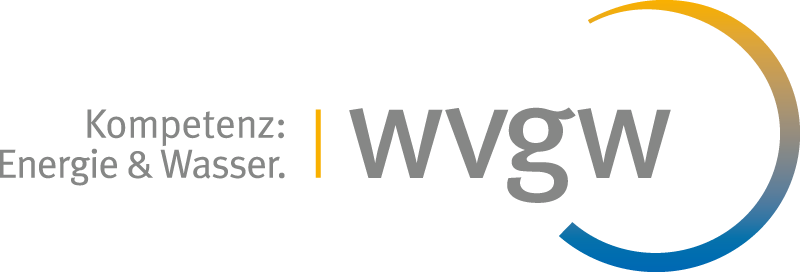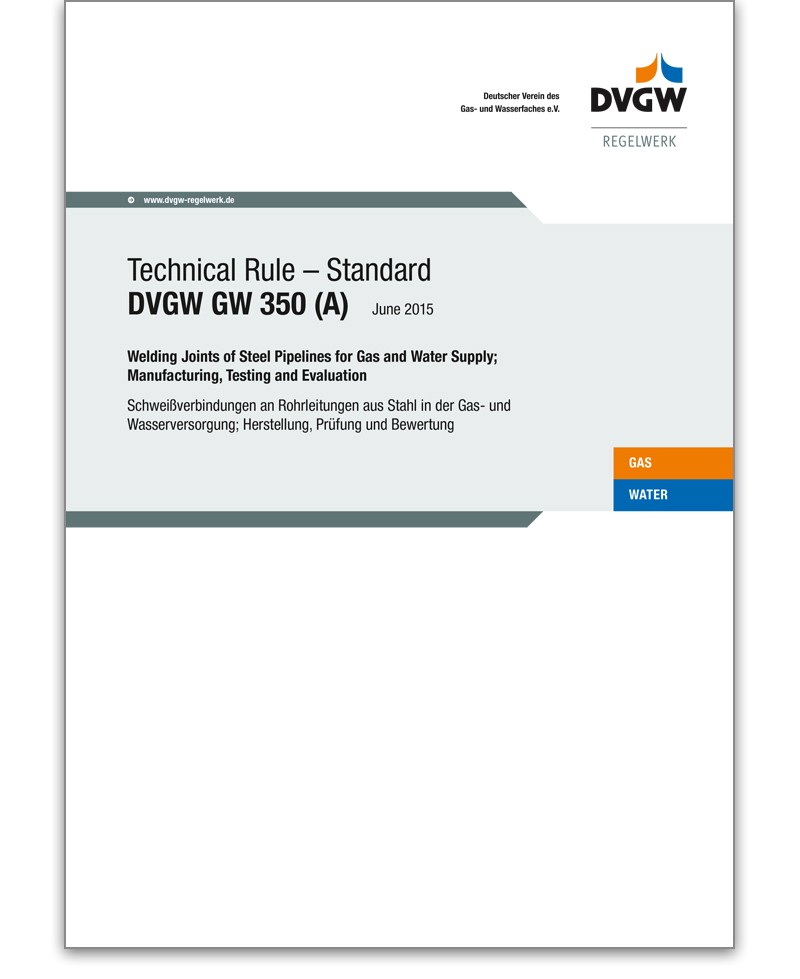GW 350 Technical Rule - Technical 06/2015
Welding Joints of Steel Pipelines for Gas and Water Supply; Manufacturing, Testing and Evaluation ++ PDF file ++
- Herausgeber/Verlag: DVGW
- Format: 42 pages
- Material: available as PDF only
- Ausgabe: third edition 2015
- Hinweis: German version GW 350
- Verkaufseinheit: 1
- Mindestabnahme: 1
- Artikel-Nr.: 510583
79,28 €*
This Technical Rule GW 350 in conjunction with DIN EN 12732 applies to the manufacture, testing and Evaluation of welds on steel pipelines and installations which serve to supply the general public with gas within the meaning of the Energy Industry Law (EnWG) or which are part of the associated energy installations on factory premises and in the area of operational gas use and which are to be operated with the gases of the 2nd gas family according to DVGW Standard G 260 or DVGW Standard G 262. It also applies to pipes in operation.For steel pipelines and installations for gases which do not comply with the provisions of the above DVGW standards, this technical rule may be applied mutatis mutandis taking into account the specific properties of the gases and any other existing provisions.
Foreword
1 Scope
2 Normative references
3 Terms, symbols, units and abbreviations
3.1 System parts
3.2 Array technology
3.3 Design pressure (DP)
3.4 Automated Ultrasonic Testing (AUT)
3.5 Welding Procedure Qualification Record (WPQR)
3.6 Operating company
3.7 Time of Flight Diffraction (TOFD)
3.8 Functional pipes
3.9 Approved weld
3.10 Structural parts
3.11 Piping system
3.12 Pipeline components
3.13 Welding Procedure Specification (WPS)
3.14 Welding procedure qualification
3.15 Pre-production welding test
3.16 Preliminary Welding Procedure Specification (pWPS)
3.17 Wall thickness
4 Quality requirement levels
5 Organisational requirements
6 Welding and testing personnel
6.1 Welding supervisor
6.2 Welders and operators of mechanised welding equipment
6.3 Test personnel
6.4 Testing companies
7 Qualification of welding procedures
7.1 Welding procedure specifications for the qualification of welding procedures
7.2 Welding procedure qualification test
7.2.1 General
7.2.2 Scope of application of the welding procedure qualification test for vertical-down welds
7.2.3 Test requirements for welding procedure qualification tests
7.2.3.1 General
7.2.3.2 Notched bar impact bending test
7.2.3.3 Transverse tensile test
7.2.3.4 Tensile test in the pure weld metal
8 Production of the welding joint
8.1 Basic principles
8.1.1 General
8.1.2 Welding procedure specification
8.1.3 Working space
8.1.4 Weather conditions
8.2 Weld preparation
8.2.1 General
8.2.2 Weld pitches
8.2.3 Pipe cuts
8.2.4 Mitre cuts
8.2.5 Preparation of weld areas
8.2.6 Sockets and sleeve joints
8.2.7 Pipe branches and branch tees
8.2.8 Cross joints
8.2.9 Laminar imperfections on gas pipelines
8.2.10 Linear offset
8.3 Setting up and centring
8.4 Welding
8.4.1 Filler metals and auxiliary materials
Tacking
8.4.3 Preheating
8.4.4 Execution of welding
8.4.5 Welding-on construction parts
8.4.6 Weld after-treatment
8.4.7 Arc strikes
8.5 Repairing and cutting out welding defects
8.6 Special requirements for pipelines in gas installations
8.7 Cable connections for cathodic corrosion protection and lightning protection
8.8 Work on pipes in operation
8.9 Special requirements for the processing of stainless steels
8.9.1 General
8.9.2 Preparation
8.9.3 Execution
8.9.4 Scope of testing
8.9.5 Post-treatment
9 Testing
9.1 General
9.2 Scope of testing
9.2.1 Scope of testing for destructive testing (test welds) for quality requirement level D9.2.1 Scope of testing for destructive testing (test welds) for quality requirement level D
9.2.2 Scope of testing for non-destructive testing
9.3 Non-destructive testing
9.3.1 General
9.3.2 Visual testing (VT)
9.3.3 Surface crack testing (PT and MT)
9.3.4 Radiographic testing (RT)
9.3.5 Ultrasonic testing (UT)
9.3.5.1 Manual ultrasonic testing of welding joints
9.3.5.2 Adjustment
9.3.5.2.1 Distance adjustment
9.3.5.2.2 Testing of welding joints on curved surfaces (e.g. longitudinal welds)
9.3.5.3 Criteria for the evaluation of indicators in ultrasonic testing
9.3.5.3.1 Distance gain size method
9.3.5.3.2 General requirements
9.3.6 Time-of-flight diffraction (TOFD
9.3.7 Automated ultrasonic testing (AUT)
9.4 Time of testing
9.5 Acceptance criteria
9.6 Logging of test results
10 Documentation
10.1 General
10.2 Requirements on the welding documentation
Annex A (normative) ? Compensation of wall thickness differences
Bibliography
1 Scope
2 Normative references
3 Terms, symbols, units and abbreviations
3.1 System parts
3.2 Array technology
3.3 Design pressure (DP)
3.4 Automated Ultrasonic Testing (AUT)
3.5 Welding Procedure Qualification Record (WPQR)
3.6 Operating company
3.7 Time of Flight Diffraction (TOFD)
3.8 Functional pipes
3.9 Approved weld
3.10 Structural parts
3.11 Piping system
3.12 Pipeline components
3.13 Welding Procedure Specification (WPS)
3.14 Welding procedure qualification
3.15 Pre-production welding test
3.16 Preliminary Welding Procedure Specification (pWPS)
3.17 Wall thickness
4 Quality requirement levels
5 Organisational requirements
6 Welding and testing personnel
6.1 Welding supervisor
6.2 Welders and operators of mechanised welding equipment
6.3 Test personnel
6.4 Testing companies
7 Qualification of welding procedures
7.1 Welding procedure specifications for the qualification of welding procedures
7.2 Welding procedure qualification test
7.2.1 General
7.2.2 Scope of application of the welding procedure qualification test for vertical-down welds
7.2.3 Test requirements for welding procedure qualification tests
7.2.3.1 General
7.2.3.2 Notched bar impact bending test
7.2.3.3 Transverse tensile test
7.2.3.4 Tensile test in the pure weld metal
8 Production of the welding joint
8.1 Basic principles
8.1.1 General
8.1.2 Welding procedure specification
8.1.3 Working space
8.1.4 Weather conditions
8.2 Weld preparation
8.2.1 General
8.2.2 Weld pitches
8.2.3 Pipe cuts
8.2.4 Mitre cuts
8.2.5 Preparation of weld areas
8.2.6 Sockets and sleeve joints
8.2.7 Pipe branches and branch tees
8.2.8 Cross joints
8.2.9 Laminar imperfections on gas pipelines
8.2.10 Linear offset
8.3 Setting up and centring
8.4 Welding
8.4.1 Filler metals and auxiliary materials
Tacking
8.4.3 Preheating
8.4.4 Execution of welding
8.4.5 Welding-on construction parts
8.4.6 Weld after-treatment
8.4.7 Arc strikes
8.5 Repairing and cutting out welding defects
8.6 Special requirements for pipelines in gas installations
8.7 Cable connections for cathodic corrosion protection and lightning protection
8.8 Work on pipes in operation
8.9 Special requirements for the processing of stainless steels
8.9.1 General
8.9.2 Preparation
8.9.3 Execution
8.9.4 Scope of testing
8.9.5 Post-treatment
9 Testing
9.1 General
9.2 Scope of testing
9.2.1 Scope of testing for destructive testing (test welds) for quality requirement level D9.2.1 Scope of testing for destructive testing (test welds) for quality requirement level D
9.2.2 Scope of testing for non-destructive testing
9.3 Non-destructive testing
9.3.1 General
9.3.2 Visual testing (VT)
9.3.3 Surface crack testing (PT and MT)
9.3.4 Radiographic testing (RT)
9.3.5 Ultrasonic testing (UT)
9.3.5.1 Manual ultrasonic testing of welding joints
9.3.5.2 Adjustment
9.3.5.2.1 Distance adjustment
9.3.5.2.2 Testing of welding joints on curved surfaces (e.g. longitudinal welds)
9.3.5.3 Criteria for the evaluation of indicators in ultrasonic testing
9.3.5.3.1 Distance gain size method
9.3.5.3.2 General requirements
9.3.6 Time-of-flight diffraction (TOFD
9.3.7 Automated ultrasonic testing (AUT)
9.4 Time of testing
9.5 Acceptance criteria
9.6 Logging of test results
10 Documentation
10.1 General
10.2 Requirements on the welding documentation
Annex A (normative) ? Compensation of wall thickness differences
Bibliography

